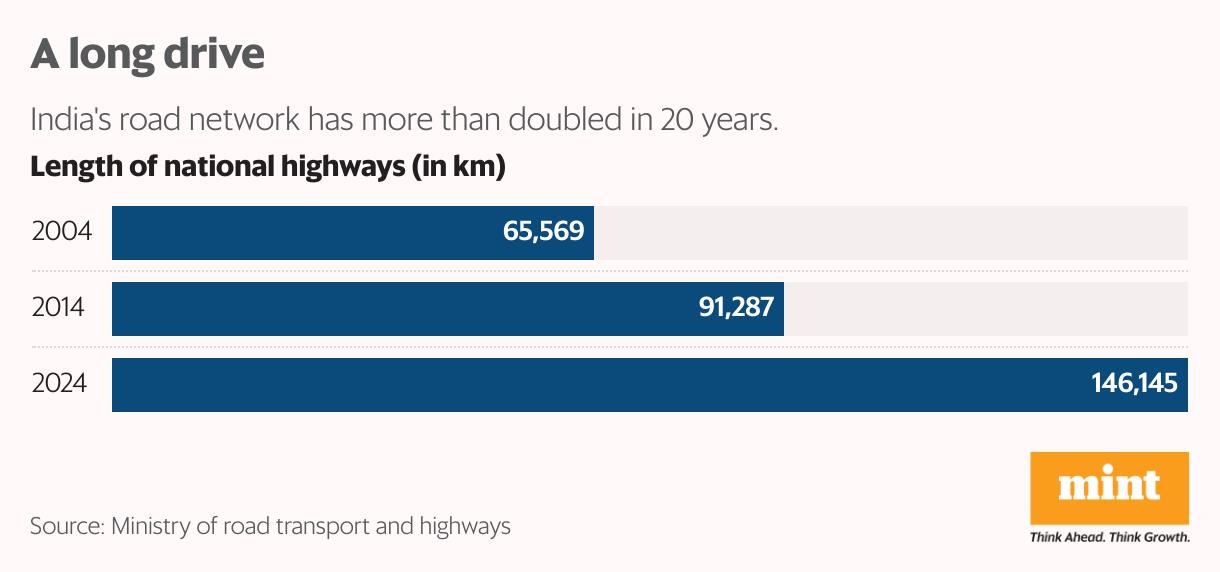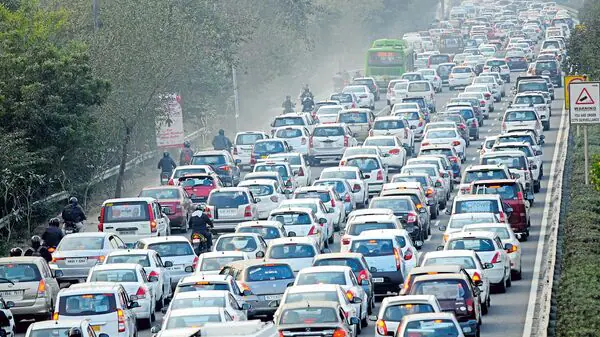
Golden Quadrilateral 2.0: New Expressway Grid To Redraw India's Economic Map
The Union government is planning a sequel to the Golden Quadrilateral network of national highways, introducing high-speed expressways linking India's major economic centres, two officials said.
New expressways would be developed along the East-West and North-South corridors and the Golden Quadrilateral highway networks in 5-7 years to create a seamless grid connecting major cities, they said.
High-speed expressways are typically access-controlled, ensuring uninterrupted traffic between cities by keeping out slow-moving vehicles and limiting entry and exit points.
Also Read | Why India wants private money to build and run highways agThe new expressways are meant to offer commuters and freight carriers high-speed alternatives to crowded national highways as well as help reduce the country's high logistics costs, one of the two officials said.
The North-South and East-West corridors were launched in 1998, and the Golden Quadrilateral highways project in 2001, as part of the National Highways Development Project, creating an economic corridor through major cities and towns across the country.

“The plan mirrors the existing Golden Quadrilateral and the East-West and North-South highway corridors... All planned high-speed corridors [will be] either parallel to these networks or supplement them," the second official said.“The existing highway network is severely congested and choked."
The officials, who declined to be identified, did not disclose the planned length of the proposed new high-speed expressways or the investment.
The ministry of road transport and highways has already awarded 9,000 km of expressway projects and plans to award another 10,000 km of high-speed highway projects during 2025-26 and 2026-27. The new expressways, which will be part of these projects, will link key economic centres falling some distance off the Golden Quadrilateral network, the officials said.
The initial investment for these projects, which will be part of the government's Vision 2047 plan, is still being worked out, according to the officials. The cost of constructing expressways typically exceeds ₹40 crore per km, depending on the terrain and land costs.
The highways ministry did not reply to Mint's queries.
Also Read | Bonanza for investors as new road builders may get to toll old onesThe Golden Quadrilateral and the North-South and East-West highway corridors currently measure about 13,500 km. Vision 2047 refers to the government's ambition to transform India into a developed nation by the time the country celebrates its 100th year of Independence.
Next-gen infrastructureExperts said the government's focus on developing complex projects such as expressways marks a decisive shift toward building next-generation transport infrastructure.
“The plan to construct 20,000–25,000 km of expressways over the next five years-creating a Golden Quadrilateral and East-West/North-South grid of high-speed corridors-can be transformative if executed well," said Jagannarayan Padmanabhan, senior director and global head, consulting, Crisil Intelligence.
“High-speed corridors significantly enhance logistics efficiency by cutting travel time, improving reliability and reducing [India's] logistics costs-currently among the highest globally at 11–12% of GDP," he added.“Such corridors will not only boost freight movement and industrial competitiveness but also catalyse the development of economic clusters, logistics parks and new urban centres along these routes."
Highlighting the need for new high-speed expressways across the country, Kuljit Singh, partner and national infrastructure leader, EY India, noted that the average speed of vehicles in India tends to be slow as existing highways are exposed to local traffic, congestion, and design constraints.“The Golden Quadrilateral of normal highways was initiated in the early 2000's, and, hence, due to increase in traffic over the years there is a need to have new highways."
Also Read | Centre overhauls highways construction bid procAccording to an estimate by Bhavik Damodar, partner, Deloitte India, the cost of building the initial network of 17,000 km of new high-speed expressways by 2033 would be about ₹11 trillion.
“... The plan could be made feasible through a mix of smart financing strategies. The government can leverage public-private partnerships (hybrid annuity and build-operate-transfer models), budget allocations, and international funding to spread out the financial burden," said Damodar.
“The Golden Quadrilateral has already demonstrated how such infrastructure can drive growth and connectivity, and expanding this network will build on that success by linking more parts of the country," he added.
Legal Disclaimer:
MENAFN provides the
information “as is” without warranty of any kind. We do not accept
any responsibility or liability for the accuracy, content, images,
videos, licenses, completeness, legality, or reliability of the information
contained in this article. If you have any complaints or copyright
issues related to this article, kindly contact the provider above.
Most popular stories
Market Research

- Solo Leveling Levels Up: Korean Billion-Dollar Megafranchise Goes Onchain With Story
- Freedom Holding Corp. (FRHC) Shares Included In The Motley Fool's TMF Moneyball Portfolio
- From Tracking To Thinking: Edgen's“Smart Portfolio” Brings Portfolio-Native Multi-Agent Reasoning To Asset Portfolios
- Cregis At FOREX Expo 2025: Connecting Forex With Crypto Payment
- Currency Relaunches Under New Leadership, Highlights 2025 Achievements
- Cregis At TOKEN2049 Singapore 2025: Unlocking The Next Frontier Of Adoption




















Comments
No comment